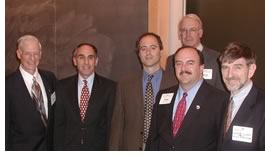
Smart Growth Symposium
Md. governor gives keynote, D.C. and Va. officials speak with designers
At a policy forum held in advance of last month's elections, public officials and planners from Maryland, Virginia, and the District of Columbia agreed that economic development and smart growth can occur simultaneously and pointed to successful area projects that have revitalized communities and increase municipal revenues, John Ratliff, the AIA's director of the Center for Livable Communities reports.
Public officials from the D.C. metro region gathered with architects and planners for a discussion of smart growth policy at the University of Maryland School of Architecture in College Park. The Washington Region Architects and Planners sponsored the event, which featured speakers Maryland Gov. Parris N. Glendening (D); Chris Zimmerman (D), chair of the Arlington County, Va., Board of Supervisors and the Washington Metropolitan Area Transit Authority (WMATA) Board of Directors; Andrew Altman, director of planning in the D.C. Mayor's office; and Robert Peck, who formerly headed up the AIA's Government Affairs department and is now chair of the Washington Board of Trade.
 In
a discussion led by Neal Fitzpatrick, participants lamented spending on
unfettered development and pointed to specific ways smart growth has benefited
their communities.
In
a discussion led by Neal Fitzpatrick, participants lamented spending on
unfettered development and pointed to specific ways smart growth has benefited
their communities.
"We spend billions of dollars accommodating sprawl," not only by spending to develop new infrastructure, but by using state funds to provide social services to abandoned communities, Glendening said in his keynote address. "Maryland's smart growth program is very conservative because it attempts to save older areas and the cost of wasteful spending," he said.
Maryland's program is incentive-based and preserves local decision-making, Glendening explained. While local governments may approve any project, the state links its infrastructure funds only in areas targeted for growth. In the nation's capital, Mayor Anthony Williams (D) has created a task force and charged it with coming up with guidelines to help the city rebuild its urban fabric, maximize access to transit, and take advantage of development opportunities in primarily defunct areas, including at St. Elizabeth's Hospital, Altman, the city's director of planning, told the audience. The government-run mental hospital was recently listed by the National Trust for Historic Preservation as one of the most endangered sites in America.
Managing growth, transportation proliferation
Maryland has identified priority funding areas (PFAs), where the state
pays the cost of infrastructure and is a partner in development. To that
end, the state has:
• Established an office to coordinate smart growth activities
• Supported local governments' efforts to cultivate dense, well-designed
projects
• Targeted school construction funds to projects in existing communities;
the state typically spends $1.6 billion on construction costs for new
schools, and 80 percent of those funds are spent in existing communities;
local governments risk forgoing state construction funding by locating
a new school elsewhere in the jurisdiction
• Employed a historic preservation tax credit, through which 20 percent
of eligible renovation costs are immediately reimbursable
• Expanded its commitment to build parks and playgrounds in existing
communities to attract and retain families with children
• Rewritten the state rehabilitation code to facilitate the reuse
of older structures
• Facilitated research through the newly created National
Center for Smart Growth Research and Education at the University of Maryland.
Glendening called on the federal government to become a more active smart growth partner and suggested placing new federal buildings in areas that enhance existing communities, giving preference for Small Business Administration (SBA) loans to borrowers whose activities enhance existing communities, and shifting transportation funding to pay for more mass-transit options.
Zimmerman, the recently re-elected Arlington representative, emphasized
the importance of mass transit and said the arrival of Metro was the key
change that made density possible in his jurisdiction. Planners originally
slated the subway system to run along Interstate 66, a major traffic corridor,
but Arlington officials advocated repositioning the Metro lines to older
commercial corridors. The priorities were threefold:
• Create a balanced tax base of 50 percent commercial and office
space and 50 percent residential
• Promote mixed use
• Preserve existing uses outside the corridors.
As a result, Zimmerman said, 13 million square feet of office space have been developed in Arlington county since 1980, and 92 percent of the total office space in the county is in the Metro corridors. Furthermore, he said, 46 percent of the county's real estate tax base is derived from 6.6 percent of the land. Arlington's efforts have paid off: the county just won an award for excellence from the U.S. Environmental Protection Agency for its smart growth plan.
Is the term "smart growth" cliché?
With so much talk about "smart growth," Peck, of the Washington
Board of Trade, fears that the phrase is being usurped by people who seek
to stunt growth rather than to grow smarter development. He said smart
growth advocates should be vigilant in their efforts to reach out to other
organizations, educate the public by sharing smart growth success stories,
and look for areas that that are not quite smart growth, but could be
if they incorporated more mixed-use projects.
Ralph Bennett, AIA, a professor of architecture at the University of Maryland moderated the event.
Copyright 2002 The American Institute of Architects. All rights reserved.
![]()
|
One of the panelists, Chris Zimmerman, who recently won reelection as chair of the Arlington County Board of Supervisors, has even more accomplishments to celebrate. This week, the U.S. Environmental Protection Agency honored Arlington County with an award for overall excellence at the organization's first-ever National Awards for Smart Growth Achievement for its efforts in the Rosslyn-Ballston corridor. Click here to read more about Arlington's program. |
|